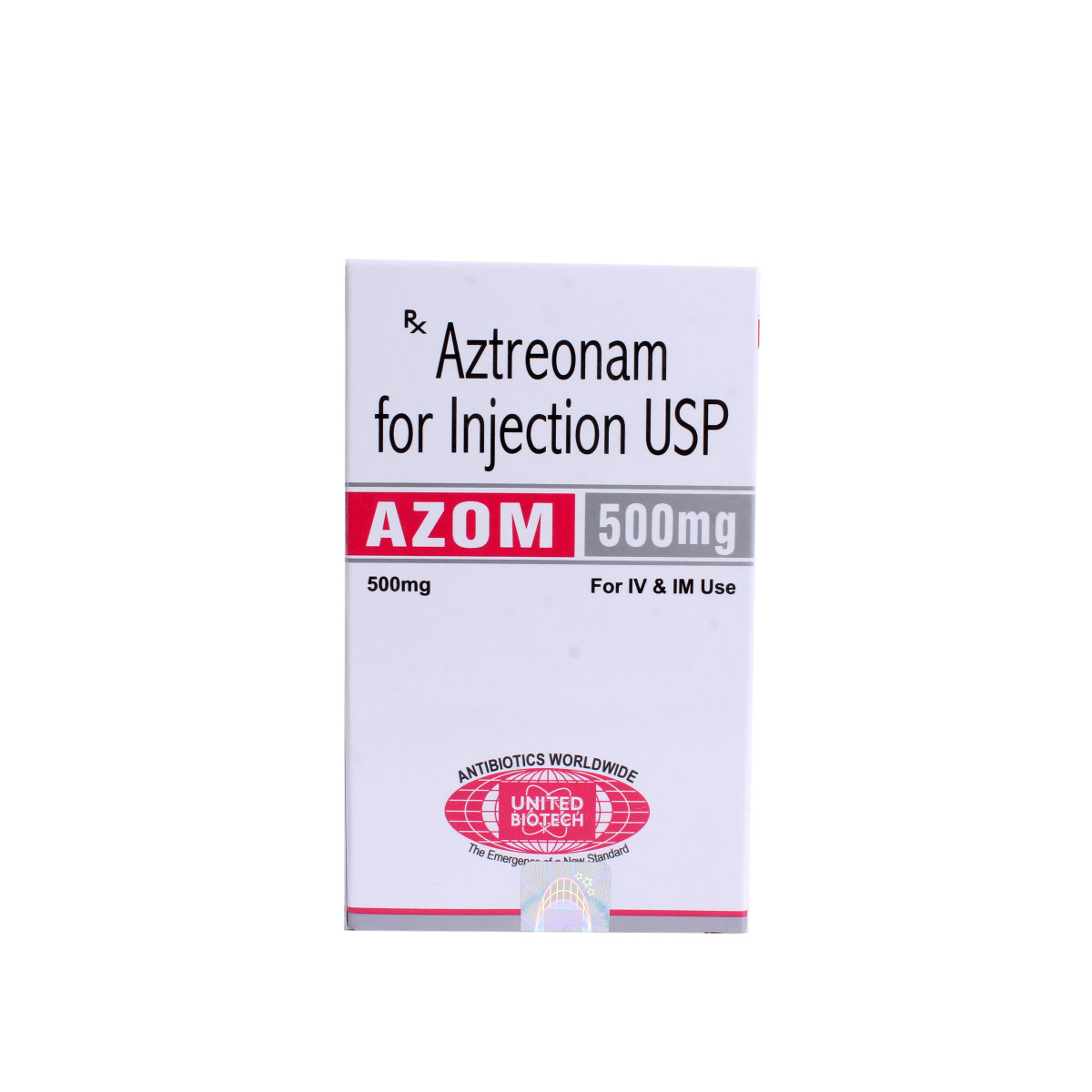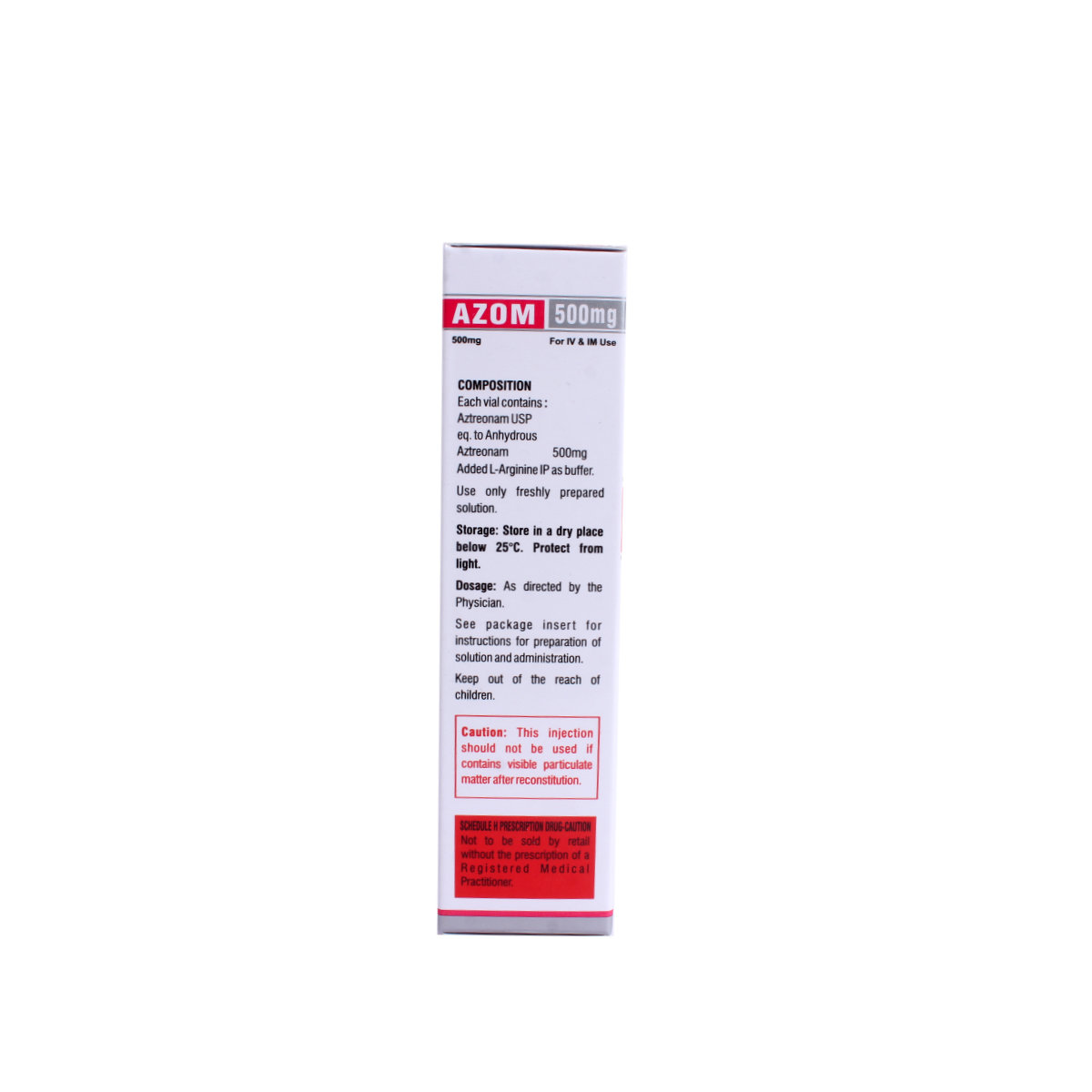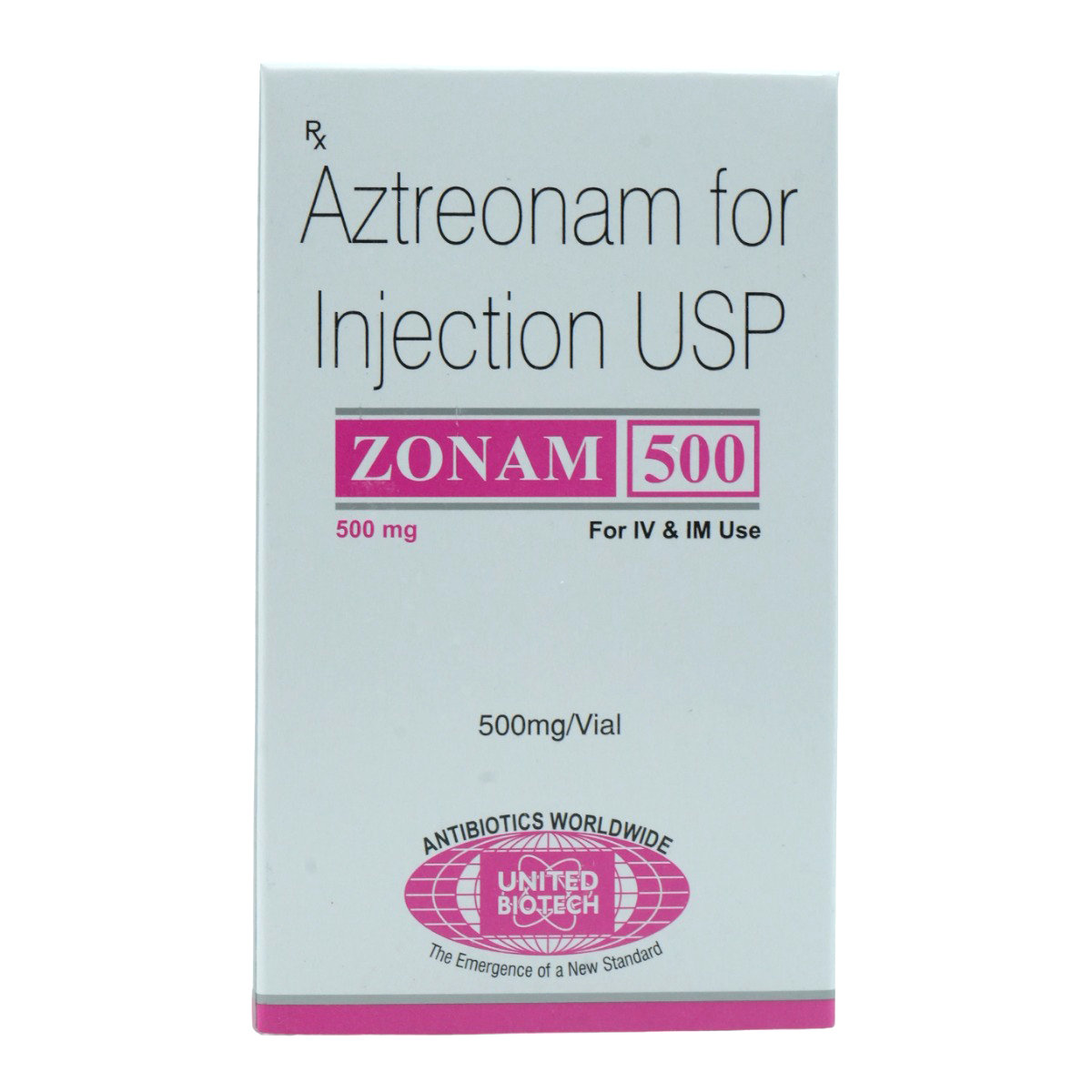AZOM 500MG INJECTION






MRP ₹478
(Inclusive of all Taxes)
₹71.7 Cashback (15%)
Provide Delivery Location
Online payment accepted
 Prescription drug
Prescription drugWhats That
Composition :
Manufacturer/Marketer :
Consume Type :
Expires on or after :
Return Policy :
About AZOM 500MG INJECTION
AZOM 500MG INJECTION belongs to a class of antibiotics used in the treatment of serious bacterial infections. A bacterial infection is a condition in which harmful bacteria grows in the body and causes infection. It can infect any part of the body and multiple very quickly.
AZOM 500MG INJECTION contains aztreonam, which belongs to a class of monobactam antibiotics. It works by inhibiting the formation of the bacterial cell wall (a protective covering) that is necessary for their survival.
Some common side effects of AZOM 500MG INJECTION include dizziness, bad breath, headache, sneezing, high temperature, bleeding of the stomach, double vision. These side effects are not familiar to everyone and vary individually. If you notice any side effects that are not manageable, please consult your doctor.
If you are known to be allergic to AZOM 500MG INJECTION or any other medicines, please tell your doctor. Do not receive AZOM 500MG INJECTION if you are pregnant or breastfeeding. Consult your doctor immediately if you notice signs of allergic reaction such as swelling of the face, lips, throat, and/or tongue with difficulty in breathing after receiving AZOM 500MG INJECTION.
Uses of AZOM 500MG INJECTION
Directions for Use
Key Benefits
AZOM 500MG INJECTION belongs to the class of monobactam antibiotics. It reduces the infection by inhibiting bacterial growth. It kills the bacteria by disrupting the formation of the cell wall. It irreversibly binds to the proteins in the bacteria that are essential for the formation of the cell membrane.
Storage
- Inform Your Doctor: Notify your doctor immediately about your diarrhoea symptoms. This allows them to adjust your medication or provide guidance on managing side effects.
- Stay Hydrated: Drink plenty of fluids to replace lost water and electrolytes. Choose water, clear broth, and electrolyte-rich drinks. Avoid carbonated or caffeinated beverages to effectively rehydrate your body.
- Follow a Bland Diet: Eat easy-to-digest foods to help firm up your stool and settle your stomach. Try incorporating bananas, rice, applesauce, toast, plain crackers, and boiled vegetables into your diet.
- Avoid Trigger Foods: Steer clear of foods that can worsen diarrhoea, such as spicy, fatty, or greasy foods, high-fibre foods, and dairy products (especially if you're lactose intolerant).
- Practice Good Hygiene: Maintain good hygiene to prevent the spread of infection. To stay healthy, wash your hands frequently, clean and disinfect surfaces regularly, and avoid exchanging personal belongings with others.
- Take Anti-Diarrheal Medications: If your doctor advises, anti-diarrheal medications such as loperamide might help manage diarrhoea symptoms. Always follow your doctor's directions.
- Keep track of your diarrhoea symptoms. If they don't get better or worse or are accompanied by severe stomach pain, blood, or dehydration signs (like extreme thirst or dark urine), seek medical help.
- Inform your doctor about the nausea and discuss possible alternatives to the medication or adjustments to the dosage.
- Divide your daily food intake into smaller, more frequent meals to reduce nausea.
- Opt for bland, easily digestible foods like crackers, toast, plain rice, bananas, and applesauce.
- Avoid certain foods that can trigger nausea, such as fatty, greasy, spicy, and smelly foods.
- Drink plenty of fluids, such as water, clear broth, or electrolyte-rich beverages like coconut water or sports drinks.
- Use ginger (tea, ale, or candies) to help relieve nausea.
- Get adequate rest and also avoid strenuous activities that can worsen nausea.
- Talk to your doctor about taking anti-nausea medication if your nausea is severe.
- Record when your nausea occurs, what triggers it, and what provides relief to help you identify patterns and manage your symptoms more effectively.
- Preventing Vomiting (Before it Happens)
- Take medication exactly as prescribed by your doctor. This can help minimize side effects, including vomiting.
- Having a small meal before taking your medication can help reduce nausea and vomiting.
- Talk to your doctor about taking anti-nausea medication along with your prescribed medication.
- Managing Vomiting (If it Happens)
- Try taking ginger in the form of tea, ale, or candy to help alleviate nausea and vomiting.
- What to Do if Vomiting Persists
- Consult your doctor if vomiting continues or worsens, consult the doctor for guidance on adjusting your medication or additional treatment.
- Skin rash caused by allergies is due to irritants or allergens. Therefore, avoid contact with such irritants.
- Consult your doctor for proper medication and apply an anti-itch medication. Follow the schedule and use the medication whenever needed.
- Protect your skin from extreme heat and try to apply wet compresses.
- Soak in the cool bath, which gives a soothing impact to the affected area.
- If you have symptoms such as pain, swelling, redness, or warmth in your veins after taking medication, contact your doctor right once. Share information about your symptoms, medication regimen, and medical history.
- Your doctor will then assess your medication regimen to determine if it's contributing to the thrombophlebitis. This assessment will help identify the best course of action to manage your condition and prevent further complications.
- Your doctor may suggest certain diet and lifestyle changes to help manage your condition. This may include increasing your intake of foods rich in omega-3 fatty acids, staying hydrated, exercising regularly, and maintaining a healthy weight. Your doctor may also advise medications to reduce inflammation, prevent blood clots, or manage pain if necessary.
- If your condition does not improve or persists, consult your doctor and report your condition. Your doctor will assess your progress, adjust your treatment plan if necessary, and provide appropriate advice to ensure the best possible outcome.
- If you have symptoms such as pain, swelling, redness, or warmth in your veins after taking medication, contact your doctor right once. Share information about your symptoms, medication regimen, and medical history.
- Your doctor will then assess your medication regimen to determine if it's contributing to the thrombophlebitis. This assessment will help identify the best course of action to manage your condition and prevent further complications.
- Your doctor may suggest certain diet and lifestyle changes to help manage your condition. This may include increasing your intake of foods rich in omega-3 fatty acids, staying hydrated, exercising regularly, and maintaining a healthy weight. Your doctor may also advise medications to reduce inflammation, prevent blood clots, or manage pain if necessary.
- If your condition does not improve or persists, consult your doctor and report your condition. Your doctor will assess your progress, adjust your treatment plan if necessary, and provide appropriate advice to ensure the best possible outcome.
- Stay hydrated by drinking plenty of water to help reduce swelling.
- Include anti-inflammatory foods like turmeric, ginger, and omega-3 rich foods in your diet.
- Avoid processed and high-sodium foods that can exacerbate swelling.
- Utilize an ice pack wrapped in a cloth to cool the affected area, helping to alleviate swelling and discomfort.
- Gently massage the site, if recommended by your healthcare provider, to promote lymphatic drainage.
- Rotate injection sites to minimize irritation and swelling.
- Allow your body time to rest and recuperate, limiting physically demanding tasks to facilitate a smoother recovery.
Drug Warnings
Regular monitoring of kidney and liver functioning is recommended while taking AZOM 500MG INJECTION. If you are a breastfeeding or pregnant woman, please consult a doctor before taking AZOM 500MG INJECTION. If you notice blood in stools or have severe stomach pain with diarrhoea, contact your doctor immediately. Inform your doctor before taking AZOM 500MG INJECTION if you have liver problems, kidney problems, blood disorders, fits. Also, inform your doctor if you are already taking medicines like antibiotics or oral anticoagulants.
Drug-Drug Interactions
Drug-Drug Interactions
Login/Sign Up
Coadministration of Azom 500mg Injection with Cholera vaccine can reduce the effects of Cholera vaccine.
How to manage the interaction:
Taking Azom 500mg Injection with Cholera vaccine together can result in an interaction, but it can be taken if your doctor has advised it. Do not stop using any medications without first talking to your doctor.
When BCG vaccine is used together with Azom 500mg Injection, its effectiveness may be reduced.
How to manage the interaction:
There may be a possibility of interaction between Azom 500mg Injection and BCG vaccine, but it can be taken if prescribed by a doctor. Do not stop using any medications without first talking to your doctor.
Drug-Food Interactions
Drug-Food Interactions
Login/Sign Up
Diet & Lifestyle Advise
- Take probiotics after completing the full course of AZOM 500MG INJECTION to restore some healthy bacteria in the intestines that may have been killed. Taking probiotics after antibiotic treatment can reduce the risk of antibiotic-associated diarrhoea. Certain fermented foods like cheese, yoghurt, kombucha, sauerkraut and kimchi can help to restore the good bacteria of the intestine.
- Include fibre rich foods, as they can be easily digested by your gut bacteria, which helps stimulate their growth. Thus, fibre rich foods may help restore healthy gut bacteria after a course of antibiotics. Whole grains such as whole-grain bread, brown rice should be included in your diet.
- Make sure you drink plenty of water or other fluids every day while you are taking AZOM 500MG INJECTION.
Side Effects of AZOM 500MG INJECTION
- Dizziness
- Chest pain
- Headache
- Double vision
- Bad breath
- Vaginal irritation
- Blocked nose
Habit Forming
Therapeutic Class
All Substitutes & Brand Comparisons
RX
Out of StockAzotam 500mg Injection
Trans Life Sciences
₹69
(₹62.1 per unit)
85% CHEAPERRX
Out of StockManvit 500mg Injection
₹288
(₹259.2 per unit)
39% CHEAPERRX
Out of StockForzon 500mg Injection
₹350
(₹315.0 per unit)
26% CHEAPER
Product Substitutes
Drug-Diseases Interactions
Drug-Diseases Interactions
Login/Sign Up
FAQs
AZOM 500MG INJECTION contains Aztreonam, an antibiotic that works by interfering with the formation of the bacterial cell wall (a protective covering) that is necessary for their survival. Thereby damages the bacterial cell wall and kills bacteria.
No. You should complete the full course of AZOM 500MG INJECTION as prescribed by your doctor. After completing the full course of AZOM 500MG INJECTION will work. It is important that you take AZOM 500MG INJECTION at the right dose, right times, and for the right numbers of days.
AZOM 500MG INJECTION does not work against viral infection. So, it should not be taken to treat common cold cough and cough
AZOM 500MG INJECTION may cause dizziness and double vision. So, drive only if you are alert and avoid driving and operating machinery if you feel dizzy or experience vision changes.
Drug-Drug Interactions Checker List
- WARFARIN
- ENTECAVIR
- CHOLERA VACCINE
- PEMETREXED
- DICUMAROL
Disease/Condition Glossary
A bacterial infection is a condition in which harmful bacteria grows in the body and causes infection. It can target any part of the body and multiple very quickly. Bacteria come in three basic shapes namely spherical, rod, or spiral-shaped. Bacteria may be gram-positive (have thick cell wall) or gram-negative (do not have cell wall). Appropriate tests are done to identify bacterial strains and based on the results, proper medication is prescribed. Some common symptoms of bacterial infection include cough, fever, and tiredness.

Have a query?
Buy best Infections & Infestation products by
Cipla Ltd
Macleods Pharmaceuticals Ltd
Alkem Laboratories Ltd
Lupin Ltd
Abbott India Ltd
Sun Pharmaceutical Industries Ltd
Mankind Pharma Pvt Ltd
Micro Labs Ltd
Aristo Pharmaceuticals Pvt Ltd
FDC Ltd
Intas Pharmaceuticals Ltd
Glenmark Pharmaceuticals Ltd
Ipca Laboratories Ltd
Torrent Pharmaceuticals Ltd
Zydus Healthcare Ltd
Biochem Pharmaceutical Industries Ltd
Zuventus Healthcare Ltd
United Biotech Pvt Ltd
Hetero Drugs Ltd
Emcure Pharmaceuticals Ltd
Alembic Pharmaceuticals Ltd
Indoco Remedies Ltd
Fusion Health Care Pvt Ltd
Dr Reddy's Laboratories Ltd
Leeford Healthcare Ltd
Cadila Healthcare Ltd
Wockhardt Ltd
Zydus Cadila
GlaxoSmithKline Pharmaceuticals Ltd
Morepen Laboratories Ltd
Blue Cross Laboratories Pvt Ltd
Cadila Pharmaceuticals Ltd
Converge Biotech Pvt Ltd
Elder Pharmaceuticals Ltd
Hetero Healthcare Pvt Ltd
Pfizer Ltd
AAA Pharma Trade Pvt Ltd
Gufic Bioscience Ltd
Mylan Pharmaceuticals Pvt Ltd
Corona Remedies Pvt Ltd
Wallace Pharmaceuticals Pvt Ltd
Apex Laboratories Pvt Ltd
Medishri Healthcare Pvt Ltd
Akumentis Healthcare Ltd
Alniche Life Sciences Pvt Ltd
Hegde & Hegde Pharmaceutica Llp
Veritaz Healthcare Ltd
Ranbaxy Laboratories Ltd
Koye Pharmaceuticals Pvt Ltd
Shreya Life Sciences Pvt Ltd
Overseas Health Care Pvt Ltd
Biocon Ltd
Indchemie Health Specialities Pvt Ltd
Medley Pharmaceuticals Ltd
Brinton Pharmaceuticals Ltd
J B Chemicals & Pharmaceuticals Ltd
Unifaith Biotech Pvt Ltd
Ajanta Pharma Ltd
Biochemix Health Care Pvt Ltd
Natco Pharma Ltd
Samarth Life Sciences Pvt Ltd
Unichem International
Laborate Pharmaceuticals India Ltd
Unipark Biotech Pvt Ltd
Zymes Bioscience Pvt Ltd
Indiabulls Pharmaceuticals Pvt Ltd
Neon Laboratories Ltd
Vasu Organics Pvt Ltd
DR Johns Lab Pharma Pvt Ltd
East West Pharma India Pvt Ltd
La Renon Healthcare Pvt Ltd
Medgen Drugs And Laboratories Pvt Ltd
Novartis India Ltd
Canixa Life Sciences Pvt Ltd
Icarus Health Care Pvt Ltd
Lincoln Pharmaceuticals Ltd
Celon Laboratories Pvt Ltd
Concept Pharmaceuticals Ltd
Klm Laboratories Pvt Ltd
Nicholas Piramal India Ltd
Systopic Laboratories Pvt Ltd
Yuventis Pharmaceuticals
Capital Pharma
German Remedies Ltd
Pristine Pearl Pharma Pvt Ltd
Unison Pharmaceuticals Pvt Ltd
Aurz Pharmaceutical Pvt Ltd
Clover Health Care Pharma
Kepler Healthcare Pvt Ltd
Allites Life Sciences Pvt Ltd
Auspharma Pvt Ltd
Intra Life Pvt Ltd
Jolly Healthcare
Linux Laboratories Pvt Ltd
Ozone Pharmaceuticals Ltd
Cachet Pharmaceuticals Pvt Ltd
Comed Chemicals Ltd
Delcure Life Sciences Ltd
Fresenius Kabi India Pvt Ltd
Khandelwal Laboratories Pvt Ltd
Alcohol
Safe if prescribed
The interaction of alcohol with AZOM 500MG INJECTION is unknown. Please consult a doctor before consuming alcohol while using AZOM 500MG INJECTION.
Pregnancy
Consult your doctor
The safety of AZOM 500MG INJECTION in pregnant women is unknown. Therefore, it is given to pregnant women only if the doctor thinks the benefits outweigh the risks.
Breast Feeding
Consult your doctor
AZOM 500MG INJECTION is excreted in human milk. Therefore, it is given to breastfeeding mothers only if the doctor thinks benefits are greater than risks.
Driving
Safe if prescribed
AZOM 500MG INJECTION cause double vision, dizziness as a side effect. So, avoid driving after receiving AZOM 500MG INJECTION.
Liver
Consult your doctor
Take AZOM 500MG INJECTION with caution, especially if you have a history of Liver diseases/conditions. The dose may be adjusted by your doctor as required.
Kidney
Consult your doctor
Take AZOM 500MG INJECTION with caution, especially if you have a history of Kidney diseases/conditions. The dose may be adjusted by your doctor as required.
Children
Safe if prescribed
AZOM 500MG INJECTION can be given safely to children, dose to be adjusted and recommended by a child specialist only.





